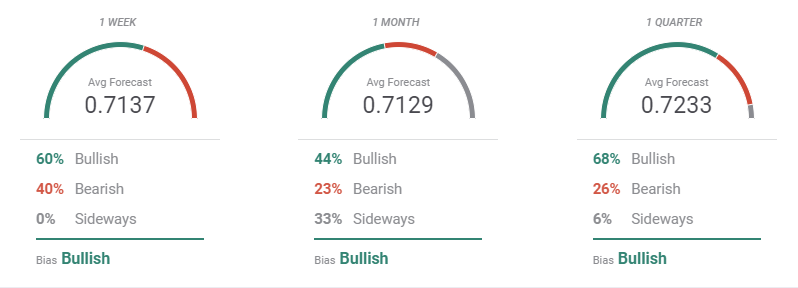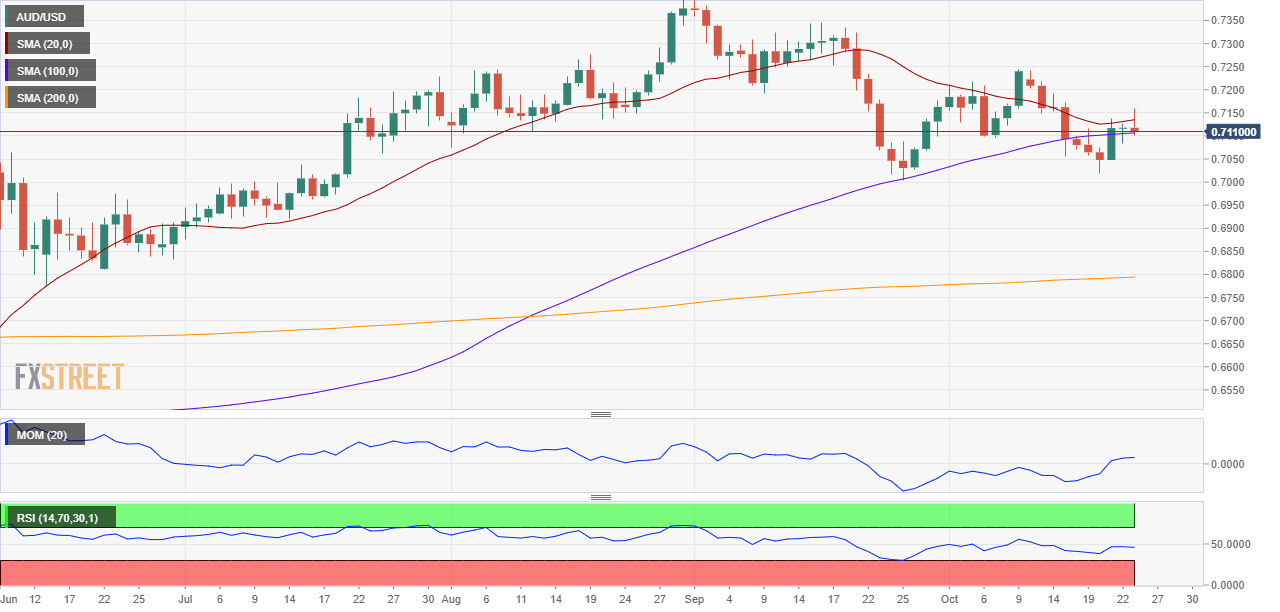- The Reserve Bank of Australia paved the way for a cash rate cut to new record lows.
- US stimulus and growth data to keep speculative interest busy next week.
- AUD/USD is gaining bearish traction, broad greenback’s weakness prevents a collapse.
The AUD/USD pair started the week on the back foot, ending it with modest gains around 0.7110. The Australian dollar got hit by the Reserve Bank of Australia Minutes, as the document paved the way for a cash rate cut to a fresh record low of 0.1%. The strength of the local currency coupled with a local economic downturn after the latest Victoria’s lockdown, are among the reasons why policymakers decided to maintain a highly accommodative policy. The next RBA meeting will take place on November 3, coinciding with the US presidential election.
US jitters flooding Australian shores
The pair bottomed at 0.7020 this week, recovering roughly 100 pips afterwards on the back of the greenback’s broad weakness. The American currency has been under pressure amid a modest improvement in the risk-related sentiment, based on hopes that US authorities will come to an agreement about a coronavirus stimulus program. Pressure on the US dollar hurts its overseas counterpart and policymakers are taking note of it.
Nevertheless, negotiations between US Treasury Secretary Steven Mnuchin and House Speaker Nancy Pelosi extended throughout the week. Both parts reported progress, and Pelosi said they were “almost there” on Thursday, but warned that it would take some time for the bill to pass the Congress. By the end of the week, hopes cooled, putting a cap to the aussie’s recovery.
A cautiously optimistic stance translated into a modest bounce from weekly lows in US stocks, which anyway ended the week in the red, preventing the commodity-linked currency from appreciating further.
Meanwhile, Australia is among countries that are baring quite well with the pandemic. As per official data, there are roughly 200 active cases in the country, with less than 20 hospitalized and none in intensive care. However, travel restrictions within the country persist, and authorities are hoping to allow interstate travel by Christmas. The economy is slowly improving, but like the rest of the world, further developments will continue to depend on the virus.
Unimpressive Australian economic figures
Data wise, China published its Q3 Gross Domestic Product last Monday, which showed that the economy grew 4.9% in the three months to September, a strong figure that anyway missed expectations. The country also released upbeat September Retail Sales and Industrial Production figures.
Meanwhile, Australian numbers were far from impressive, as the September Westpac Leading Index printed 0.22% from 0.49% in the previous month, while the preliminary estimate of Retail Sales for the same month came in at -1.5%. The preliminary October Commonwealth Bank Manufacturing PMI came in at 54.2 from 55.4 in the previous month, while the Services PMI improved to 53.8 from 50.8 in August.
The country will kick-start the week publishing its September Trade Balance and will unveil Q3 inflation figures on Wednesday. As for the US, the focus will remain on stimulus, but investors will also take care of Q3 Gross Domestic Product to be out on Thursday. The US economy is expected to have grown around 30%, a record jump.

AUD/USD technical outlook
The risk for AUD/USD has become increasingly bearish, although it’s not there yet. The weekly chart shows that the pair keeps developing between directionless 100 and 200 SMAs, and stuck around a mildly bullish 20 SMA. Technical indicators have lost their bearish strength, but consolidate within neutral levels.
The daily chart shows that the AUD/USD pair has failed to recover beyond its 20 DMA, which lacks directional strength, while it hovers around the 100 DMA. Both moving averages are confined to a tight range, indicating no directional convictions. Technical indicators are now just below their midlines, offering modest downward slopes, somehow skewing the risk to the downside without confirming it.
The bearish case will be stronger if the pair finally breaks below the 0.7000 threshold, with the next possible bearish target at 0.6920. Below this last, the pair has room to extend its decline to 0.6840. The initial barrier to the upside is the 0.7200 level, followed by the 0.7250/70 price zone.
AUD/USD sentiment poll
According to the FXStreet Forecast Poll, the AUD/USD pair will likely ignore the RBA and advance from here on. The pair is seen bullish in the three time-frame under study, averaging 0.71 in the weekly and monthly perspectives but advancing beyond 0.72 in the quarterly view. The number of those betting for a decline or seeing the pair consolidating decreased sharply in the three-month view.
As it has happened in the last few weeks, there’s a reduced number of participants betting for a slide below the 0.700 threshold, although they increase in the longer-run. Still, the Overview chart shows that moving averages are barely turning up. The most number of possible targets in three months comes above 0.7200 and extend towards 0.7700.

Related Forecasts:
EUR/USD Weekly Forecast: Growth, it’s all about economic growth
GBP/USD Weekly Forecast: Covid and Trump could cut off the Brexit bounce
Gold Weekly Forecast: XAU/USD (mostly) hinges on Trump´s electoral chances
Bitcoin Weekly Forecast: Bitcoin goes up as some of the world's largest currencies go down
Information on these pages contains forward-looking statements that involve risks and uncertainties. Markets and instruments profiled on this page are for informational purposes only and should not in any way come across as a recommendation to buy or sell in these assets. You should do your own thorough research before making any investment decisions. FXStreet does not in any way guarantee that this information is free from mistakes, errors, or material misstatements. It also does not guarantee that this information is of a timely nature. Investing in Open Markets involves a great deal of risk, including the loss of all or a portion of your investment, as well as emotional distress. All risks, losses and costs associated with investing, including total loss of principal, are your responsibility. The views and opinions expressed in this article are those of the authors and do not necessarily reflect the official policy or position of FXStreet nor its advertisers. The author will not be held responsible for information that is found at the end of links posted on this page.
If not otherwise explicitly mentioned in the body of the article, at the time of writing, the author has no position in any stock mentioned in this article and no business relationship with any company mentioned. The author has not received compensation for writing this article, other than from FXStreet.
FXStreet and the author do not provide personalized recommendations. The author makes no representations as to the accuracy, completeness, or suitability of this information. FXStreet and the author will not be liable for any errors, omissions or any losses, injuries or damages arising from this information and its display or use. Errors and omissions excepted.
The author and FXStreet are not registered investment advisors and nothing in this article is intended to be investment advice.
Recommended Content
Editors’ Picks
EUR/USD edges lower toward 1.0700 post-US PCE

EUR/USD stays under modest bearish pressure but manages to hold above 1.0700 in the American session on Friday. The US Dollar (USD) gathers strength against its rivals after the stronger-than-forecast PCE inflation data, not allowing the pair to gain traction.
GBP/USD retreats to 1.2500 on renewed USD strength

GBP/USD lost its traction and turned negative on the day near 1.2500. Following the stronger-than-expected PCE inflation readings from the US, the USD stays resilient and makes it difficult for the pair to gather recovery momentum.
Gold struggles to hold above $2,350 following US inflation

Gold turned south and declined toward $2,340, erasing a large portion of its daily gains, as the USD benefited from PCE inflation data. The benchmark 10-year US yield, however, stays in negative territory and helps XAU/USD limit its losses.
Bitcoin Weekly Forecast: BTC’s next breakout could propel it to $80,000 Premium

Bitcoin’s recent price consolidation could be nearing its end as technical indicators and on-chain metrics suggest a potential upward breakout. However, this move would not be straightforward and could punish impatient investors.
Week ahead – Hawkish risk as Fed and NFP on tap, Eurozone data eyed too

Fed meets on Wednesday as US inflation stays elevated. Will Friday’s jobs report bring relief or more angst for the markets? Eurozone flash GDP and CPI numbers in focus for the Euro.
